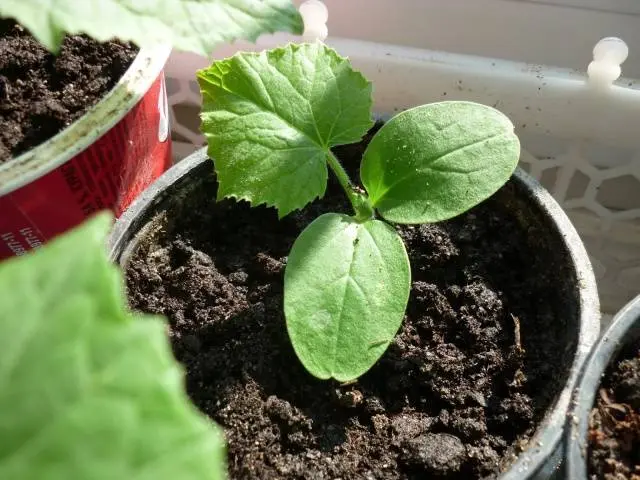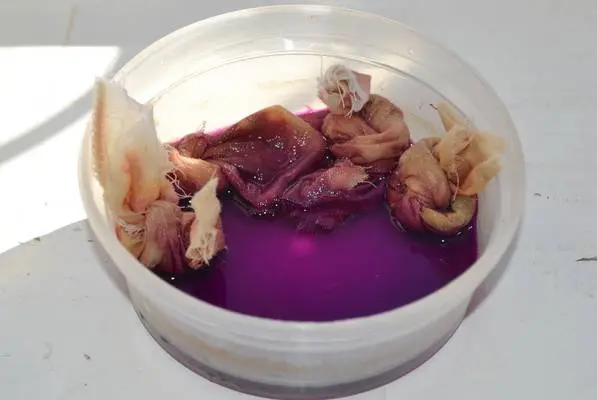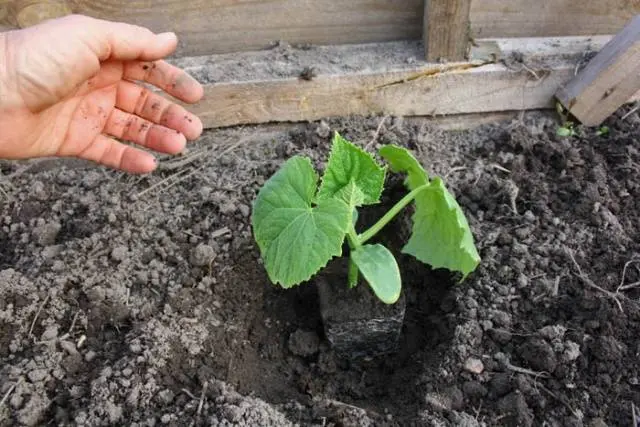Contents
Good seedlings of cucumbers at home for a greenhouse are grown in compliance with all the rules. Cucumbers are a capricious crop of the gourd family that can be grown outdoors or indoors. In the second case, the likelihood of improving the quality of the crop and getting earlier fruits increases than when grown in a garden bed. To achieve the desired results, you need to grow strong and healthy seedlings.

Growing seedlings in a house or apartment
Proper cultivation of seedlings of cucumbers involves the following steps:
- preparation of soil and containers for cultivation;
- preparation and sowing of seeds;
- seedling care;
- disembarkation to a permanent place.
In many regions, the conditions for growing cucumbers in open ground are not always optimal, therefore cucumber seedlings are often planted in a greenhouse or hotbed. In this case, the choice is made in favor of self-pollinating varieties, for pollination of which no insects are needed. It is important that the planting of cucumber seedlings is not too early. In this case, the risk of its outgrowth and weakening increases. The sprouts will be thin and elongated, pale green in color and too fragile. Such plants will not be able to produce a quality crop. Late planting threatens the development of small and weak shoots that take a long time to take root after transplanting, increasing the likelihood of a later harvest. It is better to sow seeds for seedlings 3-3,5 weeks before transplanting to a permanent place.
Soil and seed preparation
It is important to prepare the soil or buy ready-made. This will speed up and facilitate the period of adaptation of the plant to new conditions. For cucumber sprouts, you can prepare a mixture of peat, sod, manure and sawdust (4:4:1:1) or humus mixed with sod and sand (6:3:1).
The soil substrate is pre-disinfected. For this purpose, use boiling water, a solution of potassium permanganate or calcination in the oven. Then the soil is distributed in a container, which is also subjected to preliminary disinfection. It is important that the containers for each sprout are individual, since cucumber seedlings cannot stand picking. Each cup should have a drainage hole to remove excess moisture. The container is half filled with soil.

Seed material can be ordinary and processed. Normal must first be sorted. To do this, they are dipped in a strong saline solution: good seeds will sink, bad ones will float. After that, the seeds are washed, dried or processed. Treated seeds can be sown directly into the soil, they are covered with a protective layer that prevents the development of fungi and microbes. This layer also contains a number of nutrients that help the seedlings grow stronger.
Preliminary preparation of seeds for planting consists in their disinfection and stimulation.

To solve the first problem, a saturated solution of potassium permanganate is used, in which the seeds are soaked for half an hour. After that, they are dried and soaked for about 12 hours in a solution of ash, taken in an amount of 2 tbsp. l. for 1 liter of water. Then they are wrapped in wet material and left in a warm place.
After the appearance of a small root, the seeds are laid out in prepared containers and sprinkled with soil by about 2 cm. Plant growth is stimulated with a special solution, for example, Epin. Then the soil is covered with a transparent material to create a greenhouse effect. Growing high-quality seedlings requires establishing an optimal regime.
The non-germination temperature must be at least 25 °C.
Cucumbers love a lot of light, so it is important to take this feature into account and install additional lighting if it is lacking. Under such conditions, seedlings of cucumbers for the greenhouse will grow strong.
Seed care
After the appearance of sprouts, remove the transparent coating and monitor good illumination. At the same time, the temperature must be lowered by 3-5 ° C during the day, 18 ° C will be enough at night. Further seedling care is as follows:
- Watering – plentiful, regular. You can check the degree of soil moisture by taking a little soil: if it crumbles, then it needs watering, but if a lump forms, then you can skip the moisturizing procedure. For irrigation use only warm water with a temperature of 25 ° C. This condition allows the roots to develop better. In the first days, until the first leaves are fully opened, watering should be done frequently, with the advent of the second true leaf, moistening is done less often, but a little more. It is important to prevent the soil from drying out, which can lead to an oppressed state of the root system of the crop.
- Additional fertilizing – every 10 days. It is better to use liquid top dressing, alternating mineral fertilizers with organic ones. The first are bred according to the instructions, and the second – in the amount of 2 tbsp. on a bucket of settled warm water. Feed preferably in the evening, and in cloudy weather – in the morning.
- Disease control – another stage of care. Powdery mildew often infects seedlings, cold watering and a thickened planting pattern provoke its appearance. Yellowing of cucumber seedlings may be due to improper temperature conditions or a decrease in soil fertility. The wilting of foliage is promoted by high temperatures and lack of moisture, as well as a lack of mineral elements in the ground. To prevent all factors, it is important to fertilize on time, ensure normal moisture and regular ventilation. Without this, cultivation will not be effective.
Preparation and planting in the greenhouse
In order to prepare the culture for planting in a permanent place, it is hardened. Plants grown at home are very pampered and sensitive to any changes in the environment. Three-week-old seedlings begin to harden 2 weeks before transplanting. The procedure consists in a gradual decrease in temperature and regular ventilation of the room. It is important to adhere to the following points when hardening:
- hardening time every day increases by 1-2 hours;
- in the early days, the sprouts must be shaded to save them from possible combustion under direct sunlight.
Seedlings can be gradually taken out to the greenhouse, where they will grow in the future. The hardening process helps to strengthen the sprouts and improve survival after transplantation. High-quality seedlings of cucumbers before transplanting to a permanent place are characterized by:
- the presence of at least 2 pairs of true leaves;
- strong short stem;
- bright green foliage;
- developed roots.

Cucumber seedlings are planted on prepared soil in a checkerboard pattern. Planting depth should be equal to the depth of the container in which the sprout grew. In the case of transplanting flowering plants, it is better to remove the color to improve survival. When transferring sprouts with a clod of earth from a container to holes, it is important to prevent injury to the root system. Seedlings do not need to be buried; after planting, they are shed with warm water. Further cultivation consists in proper care, on which the yield and quality of the fruit will depend.









